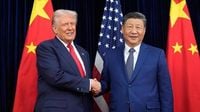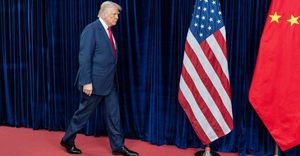On Thursday, October 30, 2025, the world’s attention turned to Busan, South Korea, where U.S. President Donald Trump and Chinese President Xi Jinping held a pivotal summit on the sidelines of the Asia-Pacific Economic Cooperation (APEC) CEO meeting. This marked the first in-person encounter between the two leaders since Trump’s return to the White House in January, and their first meeting since the G20 Summit in Osaka, Japan, back in 2019. The stakes could hardly have been higher: with the global economy rattled by a protracted trade war and fresh rounds of tit-for-tat tariffs, the talks were seen as a potential turning point for both nations—and indeed, for the world.
Heading into the summit, tensions between Washington and Beijing had reached a fever pitch. According to reporting from multiple outlets, the United States had recently expanded export controls, particularly targeting critical software, while China responded by tightening its already formidable grip on rare earth exports. These rare earths, essential for everything from smartphones to electric vehicles, are a linchpin of modern technology—and China processes over 90 percent of the world’s supply. The resulting shortages sent shockwaves through global supply chains and heightened anxieties among manufacturers and consumers alike.
Amid this backdrop, President Trump had threatened to impose a sweeping 100 percent tariff on all Chinese goods starting November 1. This move, reported by several sources, was widely seen as an effort to force Beijing’s hand in the ongoing trade dispute. Yet, just days before the summit, there was a glimmer of hope: both sides, after intensive negotiations in Malaysia, announced apparent progress and agreed on a framework for a potential trade deal. That set the stage for the high-profile Busan meeting, with observers worldwide holding their breath.
So, what did each side want? For the United States, the list was long and urgent. First and foremost, the issue of fentanyl loomed large. Trump had originally imposed tariffs on Chinese goods in February, citing what he called Beijing’s failure to stem the flow of illegal fentanyl into the United States. American officials argued that the synthetic opioid was fueling a devastating epidemic at home. China, for its part, insisted it had taken extensive steps to address the problem. The summit offered a chance to resolve this thorny issue—and, perhaps, to ease the tariffs that had been imposed in its name.
Another major sticking point was China’s control over rare earth exports. With Beijing’s new export curbs causing global shortages, Washington was desperate to ensure a stable supply of these critical minerals. U.S. farmers were also feeling the pain: China, once the largest buyer of American soybeans, had halted imports since May, leaving many in the agricultural heartland in limbo. And on the geopolitical front, Trump hoped to leverage Xi’s relationship with Moscow to help end the war in Ukraine, even threatening tariffs on China for its continued purchases of Russian oil.
Underlying all these concerns was a broader American desire for a more level playing field. The U.S. has long complained about its substantial trade deficit with China, as well as Beijing’s industrial subsidies and restrictions on foreign companies. Trump’s team made it clear that these issues were non-negotiable if relations were to improve.
China, meanwhile, had its own set of grievances. Chief among them were America’s export controls on advanced technology—especially AI chips and related software. Beijing argued that these restrictions were designed to contain its economic and technological rise. The status of Taiwan, always a flashpoint, was also on the table. China’s Communist Party claims the self-governing island as its territory and has repeatedly warned the U.S. against supporting Taiwanese independence. Finally, China sought relief from what it saw as Washington’s efforts to stymie Chinese investment and growth.
Peripheral issues abounded. The fate of TikTok’s American operations hung in the balance, with both sides reportedly making progress toward a deal that would see the social media giant’s U.S. assets sold to American buyers. Port fees had become another irritant, as both countries slapped new levies on each other’s ships. Trump also proposed discussing nuclear arms control, and even floated the idea of pressing for the release of Jimmy Lai, the jailed Hong Kong media tycoon and outspoken critic of Beijing.
After hours of talks in Busan, President Trump emerged with a major announcement. As reported by several news agencies, Trump stated that he had agreed to cut fentanyl-related tariffs on China to 10 percent, a significant reduction from earlier levels. “The dispute between China and the United States has been settled,” Trump declared, signaling a breakthrough in what had become a bruising economic standoff. He added that he looked forward to “exchanging views with Mr. Xi on important questions for the two countries,” underscoring the summit’s wide-ranging agenda.
This reduction in tariffs was no small matter. Earlier in October, Trump had unveiled additional levies of 100 percent on China’s U.S.-bound exports, along with new export controls on critical software, all set to take effect November 1. These measures were a direct response to China’s rare earth export curbs, and their rollback was seen as a key concession by Washington—one that could help restore some measure of stability to global markets.
Observers were quick to note that, while the immediate crisis may have been averted, many of the underlying issues remain unresolved. The fate of American soybean exports, the status of TikTok, and the broader strategic rivalry between the world’s two largest economies are far from settled. Yet, the willingness of both Trump and Xi to sit down and hammer out a framework for cooperation was widely interpreted as a positive sign.
“The world will be watching closely,” one analyst remarked, “because what happens between the U.S. and China doesn’t just affect them—it ripples across the entire globe.” With a 10 November deadline looming for a broader trade truce and the sale of TikTok’s American assets, the coming days promise to be just as consequential as the summit itself.
For now, at least, Busan has given both sides—and the world—a much-needed pause from escalation. Whether this fragile peace holds, or whether old tensions resurface, remains to be seen. But for a brief moment, the world’s two economic giants found common ground—and that, in today’s climate, is no small feat.




